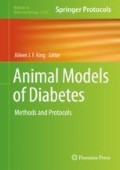Abstract
Insulin is a hormone produced and secreted by the β-cells of the pancreatic islets of Langerhans in response to increased blood glucose levels after a meal. The hormone binds to its receptor located on the plasma membrane triggering an intracellular signaling cascade. This signaling pathway is responsible for the pleiotropic actions of insulin on different tissues, such as regulation of glucose and lipid metabolism, proliferation, and differentiation. Although considerable efforts have been made to understand the molecular mechanism linking the action of the hormone to biological processes, our knowledge is incomplete. Of note, under certain conditions, physiological circulating levels of the hormone are insufficient to properly regulate these processes, a term coined as insulin resistance. The ex vivo analysis of insulin action provides valuable information to decipher intracellular signaling events downstream of the insulin receptor under physiological and pathophysiological conditions. In this chapter, we focus on the analysis of intracellular insulin action ex vivo.
Access this chapter
Tax calculation will be finalised at checkout
Purchases are for personal use only
References
Fu Z, Gilbert ER, Liu D (2013) Regulation of insulin synthesis and secretion and pancreatic Beta-cell dysfunction in diabetes. Curr Diabetes Rev 9(1):25–53
Bergman RN (2000) Non-esterified fatty acids and the liver: why is insulin secreted into the portal vein? Diabetologia 43(7):946–952
Otero YF, Stafford JM, McGuinness OP (2014) Pathway-selective insulin resistance and metabolic disease: the importance of nutrient flux. J Biol Chem 289(30):20462–20469
Kamagate A, Qu S, Perdomo G, Su D, Kim DH, Slusher S, Meseck M, Dong HH (2008) FoxO1 mediates insulin-dependent regulation of hepatic VLDL production in mice. J Clin Invest 118(6):2347–2364
Horton JD, Goldstein JL, Brown MS (2002) SREBPs: activators of the complete program of cholesterol and fatty acid synthesis in the liver. J Clin Invest 109(9):1125–1131
Valverde AM, Gonzalez-Rodriguez A (2011) IRS2 and PTP1B: two opposite modulators of hepatic insulin signalling. Arch Physiol Biochem 117(3):105–115
Shepherd PR, Withers DJ, Siddle K (1998) Phosphoinositide 3-kinase: the key switch mechanism in insulin signalling. Biochem J 333(Pt 3):471–490
Li H, Marshall AJ (2015) Phosphatidylinositol (3,4) bisphosphate-specific phosphatases and effector proteins: a distinct branch of PI3K signaling. Cell Signal 27(9):1789–1798
Sarbassov DD, Guertin DA, Ali SM, Sabatini DM (2005) Phosphorylation and regulation of Akt/PKB by the rictor-mTOR complex. Science 307(5712):1098–1101
Toker A, Marmiroli S (2014) Signaling specificity in the Akt pathway in biology and disease. Adv Biol Regul 55:28–38
Whiteman EL, Cho H, Birnbaum MJ (2002) Role of Akt/protein kinase B in metabolism. Trends Endocrinol Metab 13(10):444–451
Gonzalez E, McGraw TE (2009) The Akt kinases: isoform specificity in metabolism and cancer. Cell Cycle 8(16):2502–2508
Taniguchi CM, Emanuelli B, Kahn CR (2006) Critical nodes in signalling pathways: insights into insulin action. Nat Rev Mol Cell Biol 7(2):85–96
Acknowledgments
This work was supported by grants from the Ministerio de Economía, Industria y Competitividad: SAF2014-58702-C2-1-R and SAF2016-77871-C2-1-R to IC and SAF2014-58702-C2-2-R and SAF2016-77871-C2-2-R to GP. The EFSD European Research Programme on New Targets for Type 2 Diabetes is supported by an educational research grant from MSD to ICC and GP.
Author information
Authors and Affiliations
Corresponding author
Editor information
Editors and Affiliations
Rights and permissions
Copyright information
© 2020 Springer Science+Business Media, LLC, part of Springer Nature
About this protocol
Cite this protocol
Cózar-Castellano, I., Perdomo, G. (2020). Assessment of Insulin Tolerance Ex Vivo. In: King, A. (eds) Animal Models of Diabetes. Methods in Molecular Biology, vol 2128. Humana, New York, NY. https://doi.org/10.1007/978-1-0716-0385-7_19
Download citation
DOI: https://doi.org/10.1007/978-1-0716-0385-7_19
Published:
Publisher Name: Humana, New York, NY
Print ISBN: 978-1-0716-0384-0
Online ISBN: 978-1-0716-0385-7
eBook Packages: Springer Protocols

